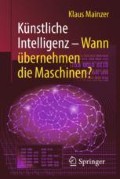Zusammenfassung
Machine Learning verändert unsere Zivilisation dramatisch. Wir verlassen uns immer mehr auf effiziente Algorithmen, weil die Komplexität unserer zivilisatorischen Infrastruktur sonst nicht zu bewältigen wäre: Unsere Gehirne sind zu langsam und bei den anstehenden Datenmengen hoffnungslos überfordert. Aber wie sicher sind KI‐Algorithmen? Bei der praktischen Anwendung beziehen sich Lernalgorithmen auf Modelle neuronaler Netze, die selber äußerst komplex sind. Sie werden mit riesigen Datenmengen gefüttert und trainiert. Die Anzahl der dazu notwendigen Parameter explodiert exponentiell. Niemand weiß genau, was sich in diesen „Black Boxes“ im Einzelnen abspielt. Es bleibt häufig ein statistisches Trial‐and‐Error Verfahren. Wie sollen aber Verantwortungsfragen z. B. beim autonomen Fahren oder in der Medizin entschieden werden, wenn die methodischen Grundlagen dunkel bleiben?
Im Machine Learning mit neuronalen Netzen benötigen wir mehr Erklärung (explainability) und Zurechnung (accountability) von Ursachen und Wirkungen, um ethische und rechtliche Fragen der Verantwortung entscheiden zu können!
Access this chapter
Tax calculation will be finalised at checkout
Purchases are for personal use only
Literatur
Peters J, Janzing D, Schölkopf B (2017) Elements of causal inference. Foundations and learning algorithms. The MIT Press, Cambridge, S 6f
Vapnik VN (1998) Statistical learning theory. Wiley, New York
Peters et al. (Anm. 1), 6, nach Figure 1.1
Mooij JM, Janzing D, Schölkopf B (2013) From ordinary differential equations to structural causal models: the deterministic case. Proceedings of the 29th Annual Conference on Uncertainty in artificiaL Intelligeence (UAI), S 440–448
Pearl J (2009) Causality: models, reasoning, and inference. Cambridge University Press, Cambridge
Peters et al. (Anm. 1), 84, nach Figure 6.1
Peters et al. (Anm. 1), 144, nach Figure 7.1
Foundation Inc OEIS (2017) The on-line encyclopedia of integer sequences. http://oeis.org/A003024.2017. Zugegriffen: 24.11.2018
Friston K, Harrison I, Penny W (2003) Dynamic causal modelling. Neuroimage 19:1273–1302
Lohmann G, Erfurth K, Müller K, Turner R (2012) Critical comments on dynamic causal modelling. Neuroimage 59:2322–2329
Knight W (2017) The dark secret at the heart of AI. Mit Technol Rev 11:1–22
Mainzer K (2018) The digital and the real world. Computational foundations of mathematics, science, technology, and philosophy. World Scientific, Singapur (Kap. 7)
Schwichtenberg H (2006) Minlog. In: Wiedijk F (Hrsg) The seventeen provers of the World. Lecture notes in artificial intelligence, Bd. 3600. Springer, Berlin, S 151–157
Nipkow T, Paulson LC, Wenzel M (2002) Isabelle/HOL. A proof assistant for higher-order logic. Springer, Heidelberg
Mainzer K (2018) Wie berechenbar ist unsere Welt. Herausforderungen für Mathematik, Informatik und Philosophie im Zeitalter der Digitalisierung. Springer, Wiesbaden
Simon H (1947) Administrative behavior: A study of decision-making processes in administrative organizations. Macmillan, New York
Bowling M, Burch N, Johanson M, Tammelin O (2015) Heads-up holdem poker is solved. Science 347(6218):145–149
Brown N, Sandholm T (2017) Reduced space and faster convergence in imperfect-information games via pruning. International Conference on Machine Learning (ICML)
Economist Staff (2015) Blockchains: The great chain of being sure about things. The Economist 31. October
Narayanan A, Bonneau J, Felten E, Miller A, Goldfeder S (2016) Bitcoin and cryptocurrency technologies. A comprehensive introduction. Princeton University Press, Princeton
Kryptowährung. Wikipedia. https://de.wikipedia.org/wiki/Kryptow%C3%A4hrung. Zugegriffen: 24.11.2018
Wikipedia (2017) Bitcoin. https://de.wikipedia.org/wiki/Bitcoin. Zugegriffen: 24.11.2018
Author information
Authors and Affiliations
Corresponding author
Rights and permissions
Copyright information
© 2019 Springer-Verlag GmbH Deutschland, ein Teil von Springer Nature
About this chapter
Cite this chapter
Mainzer, K. (2019). Wie sicher ist Künstliche Intelligenz?. In: Künstliche Intelligenz – Wann übernehmen die Maschinen?. Technik im Fokus. Springer, Berlin, Heidelberg. https://doi.org/10.1007/978-3-662-58046-2_11
Download citation
DOI: https://doi.org/10.1007/978-3-662-58046-2_11
Published:
Publisher Name: Springer, Berlin, Heidelberg
Print ISBN: 978-3-662-58045-5
Online ISBN: 978-3-662-58046-2
eBook Packages: Computer Science and Engineering (German Language)

